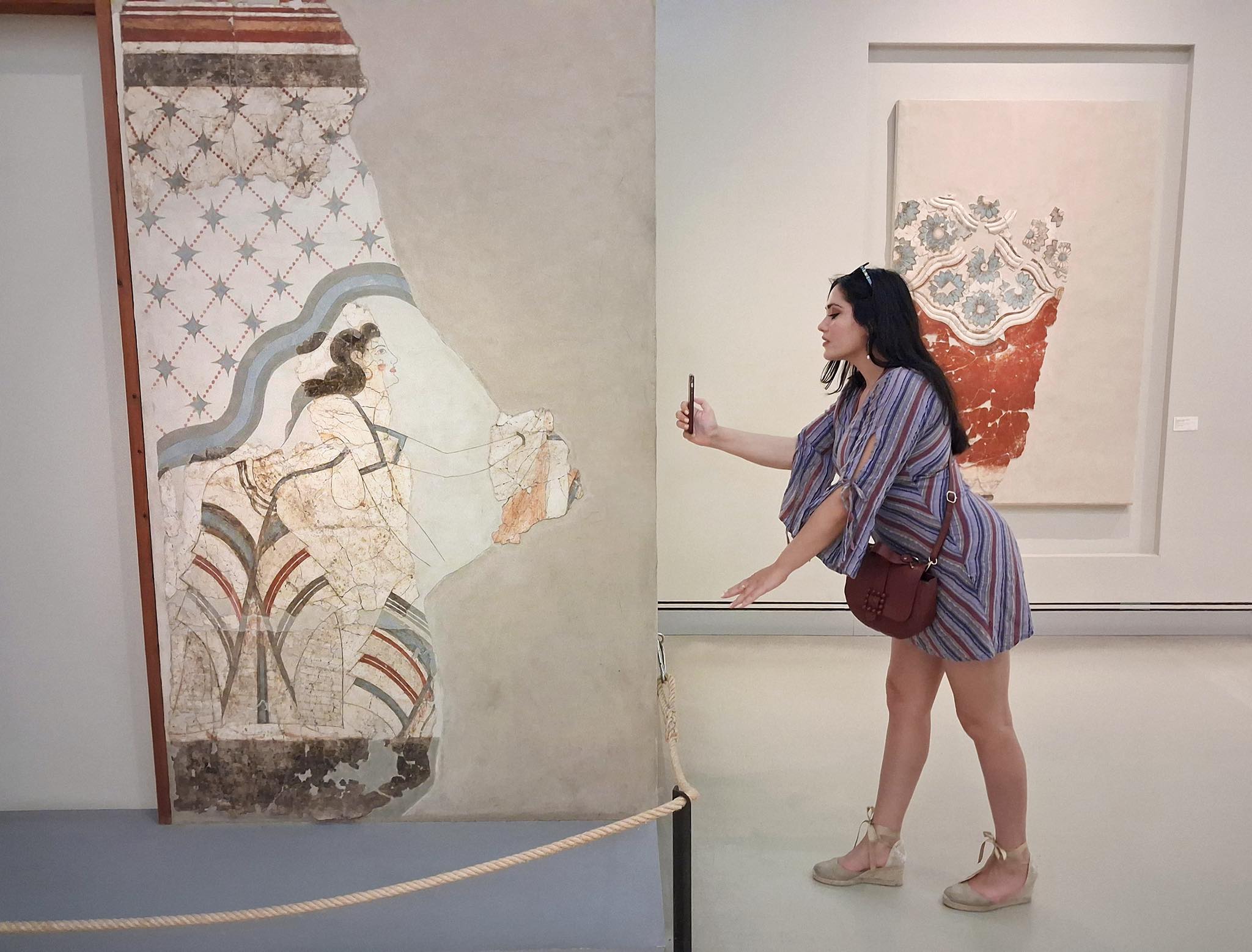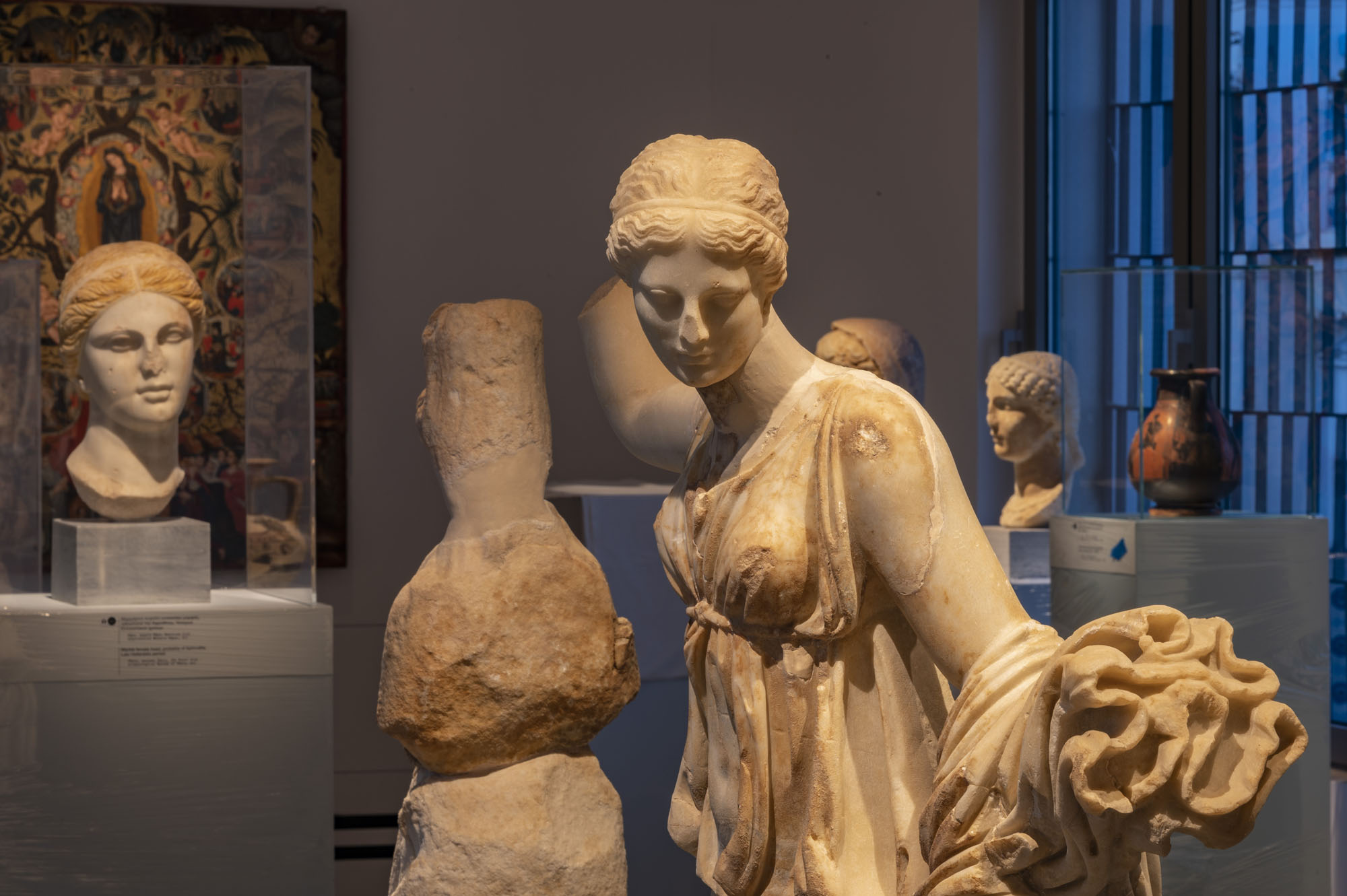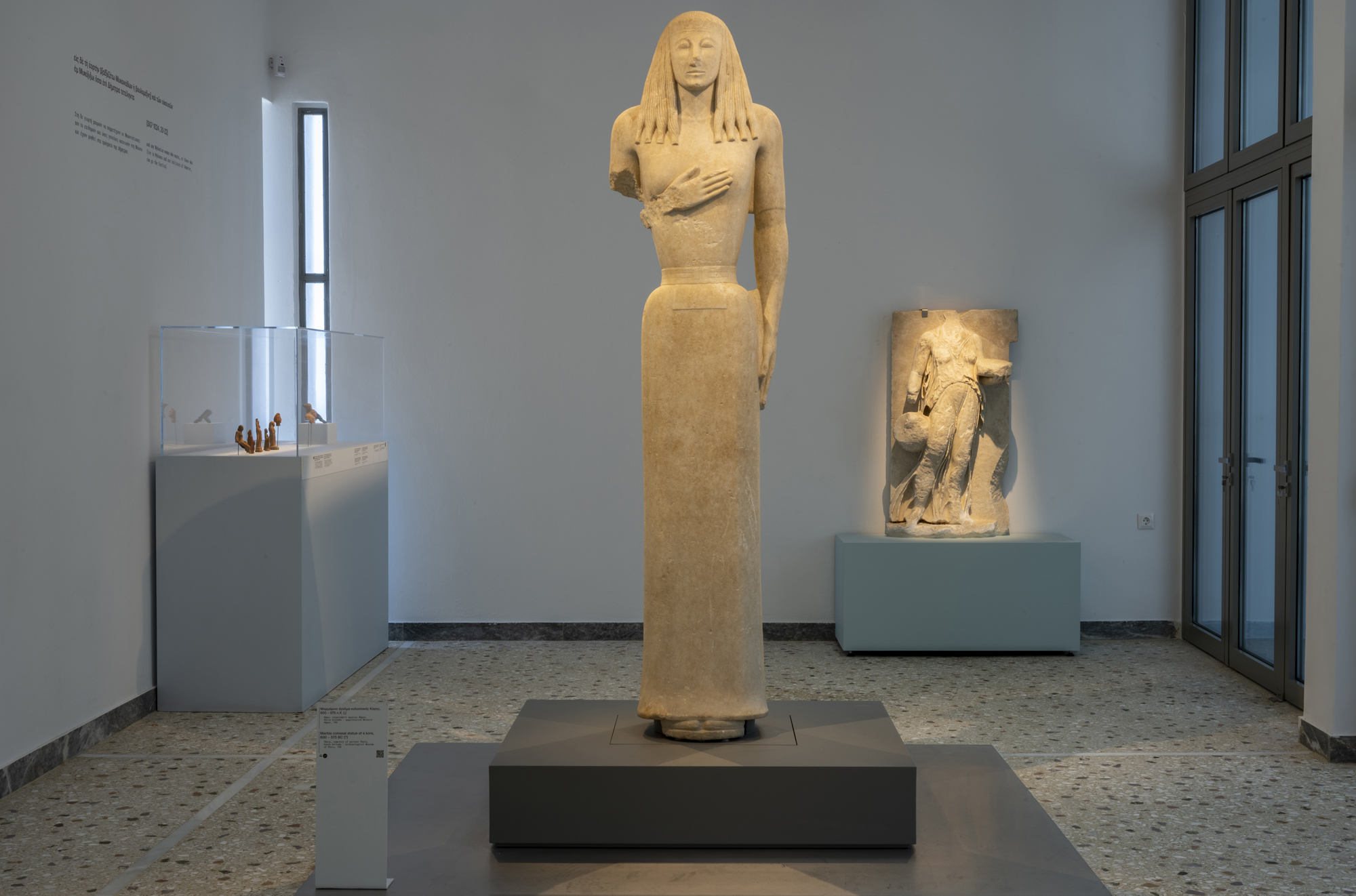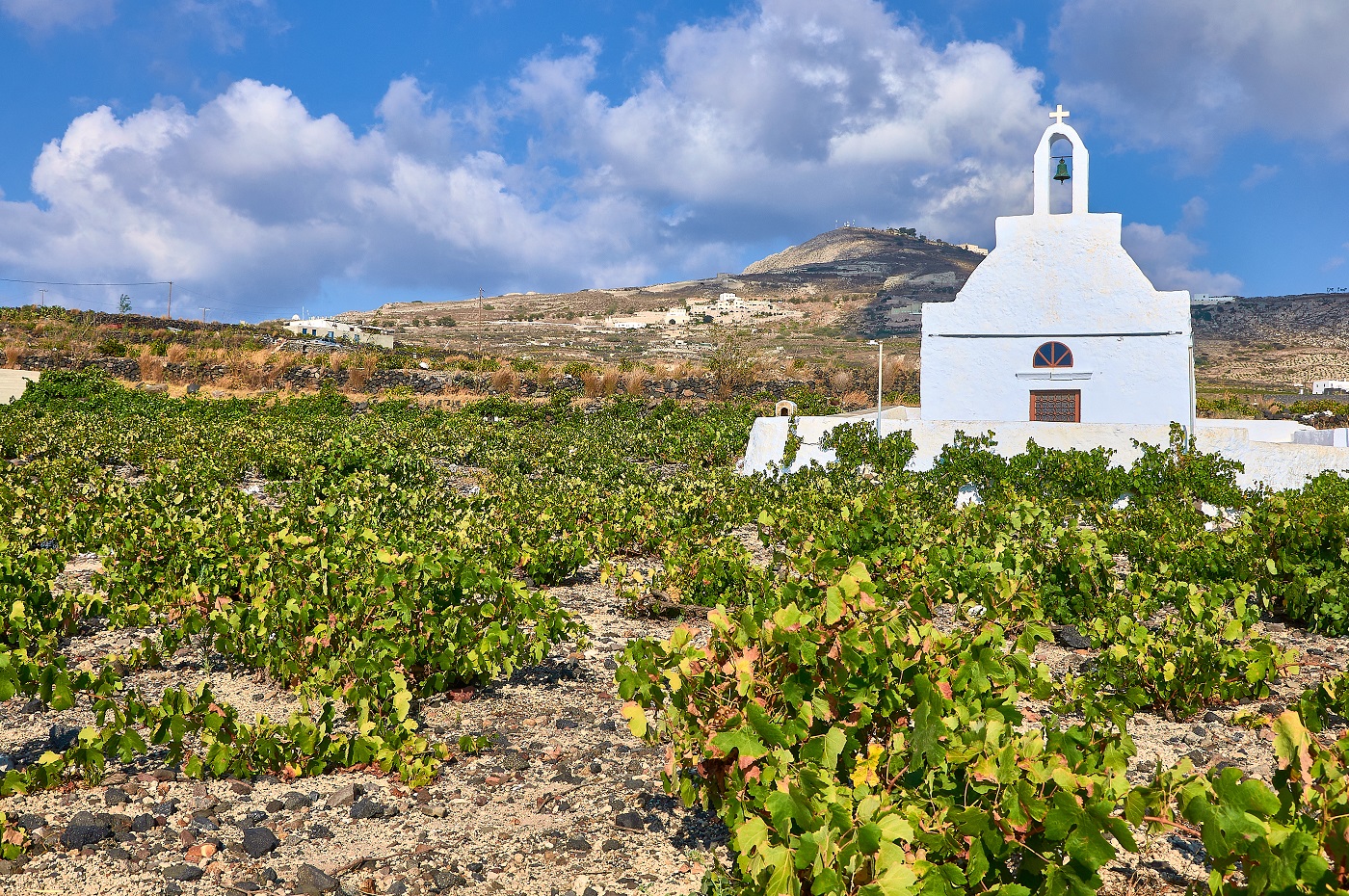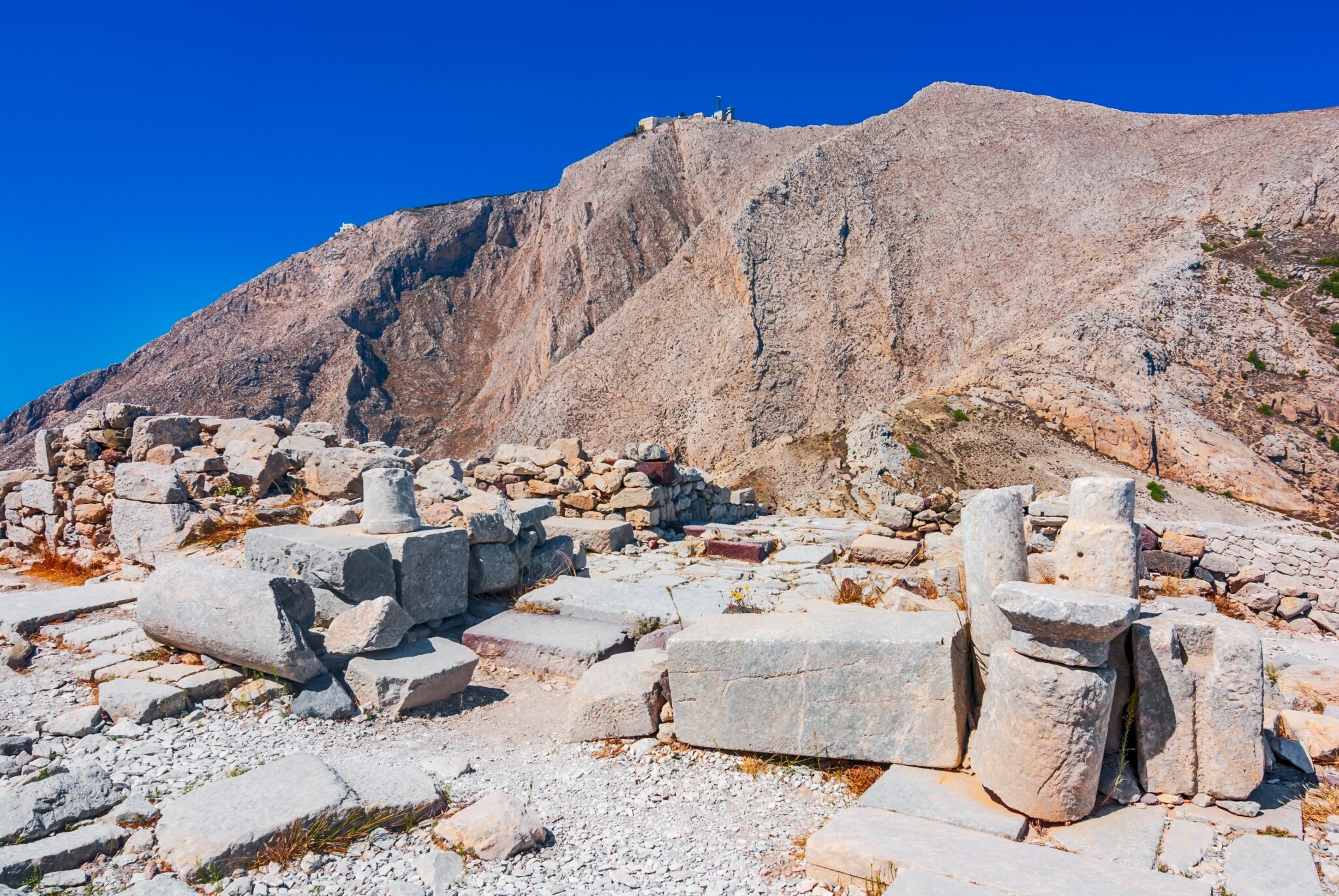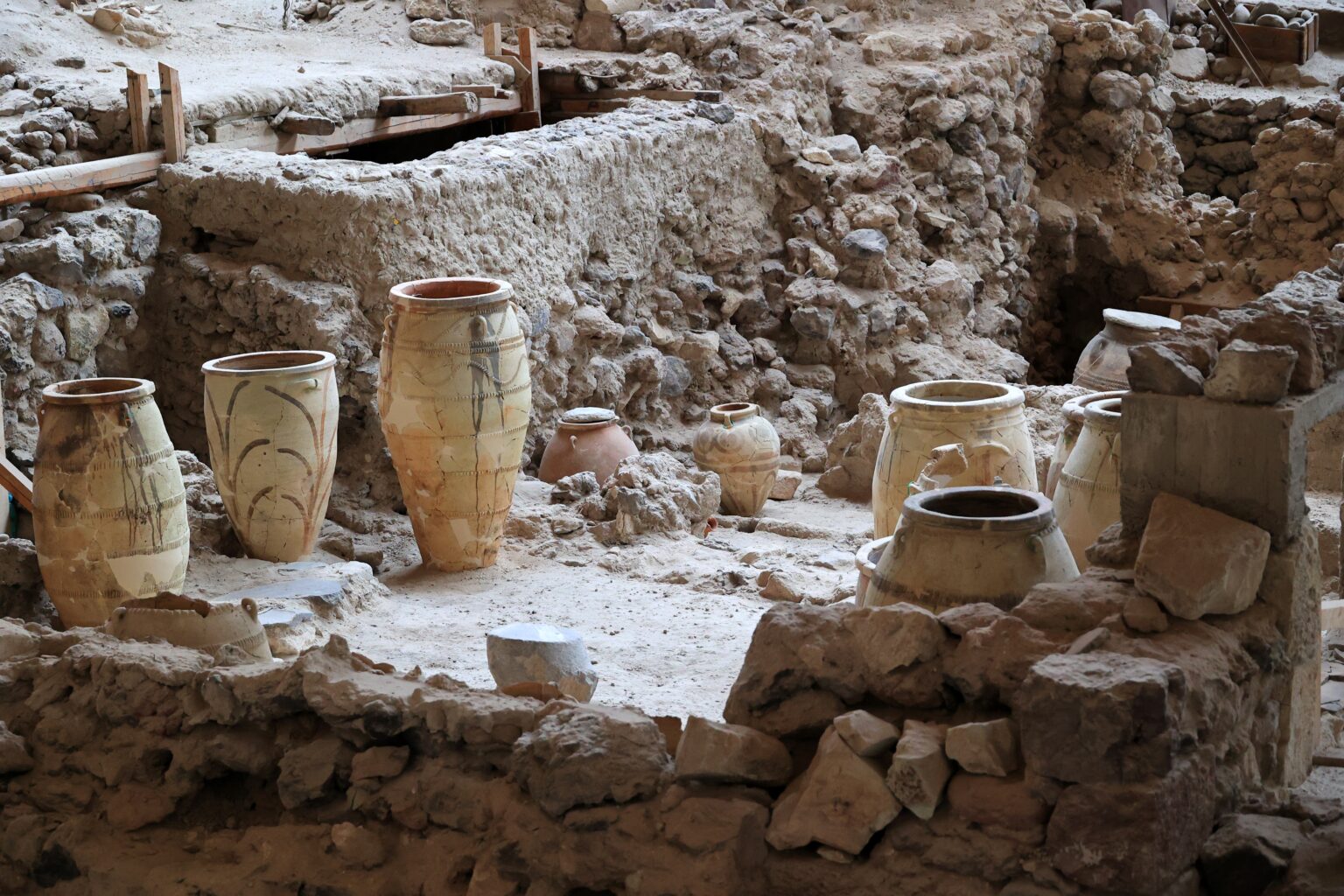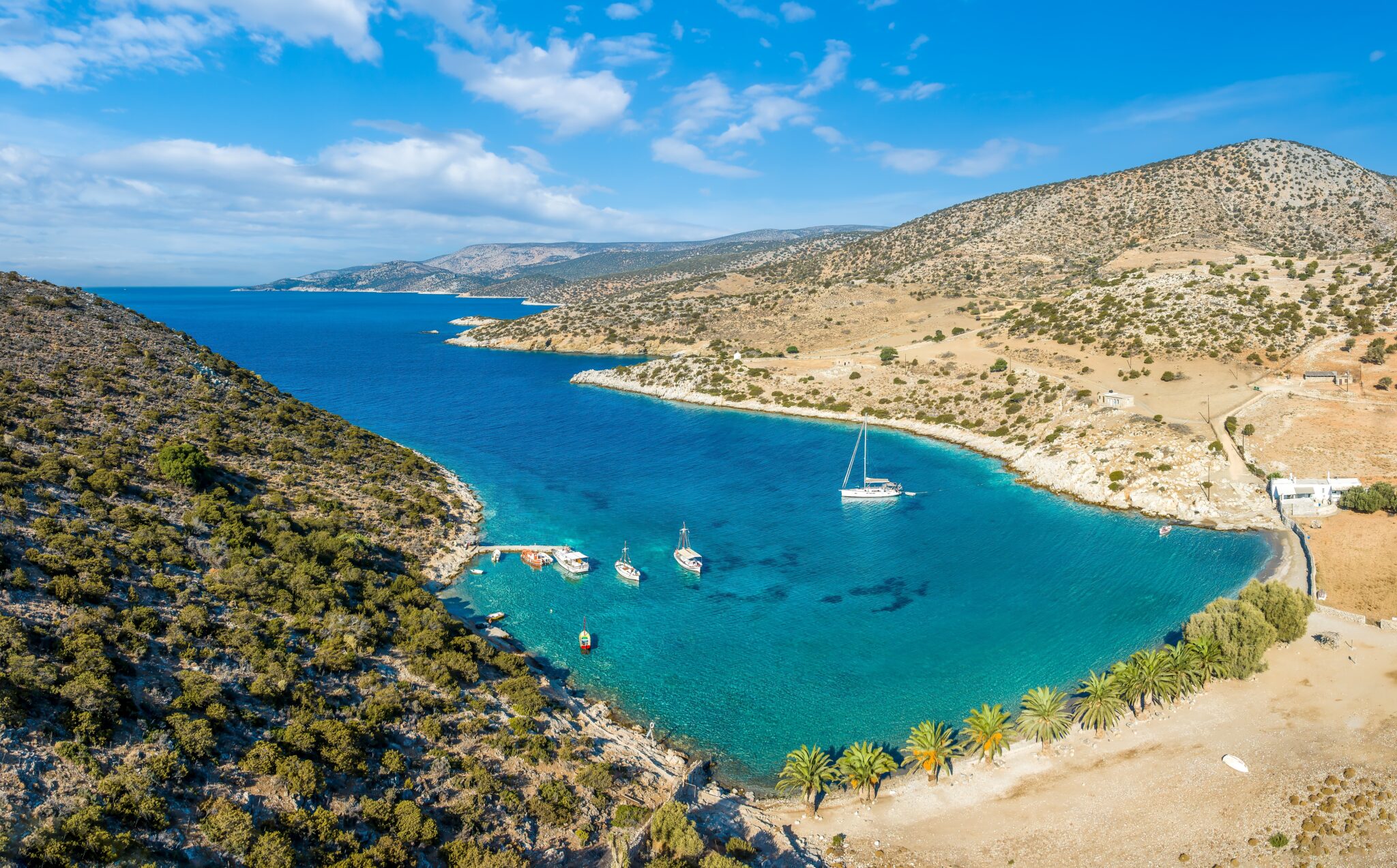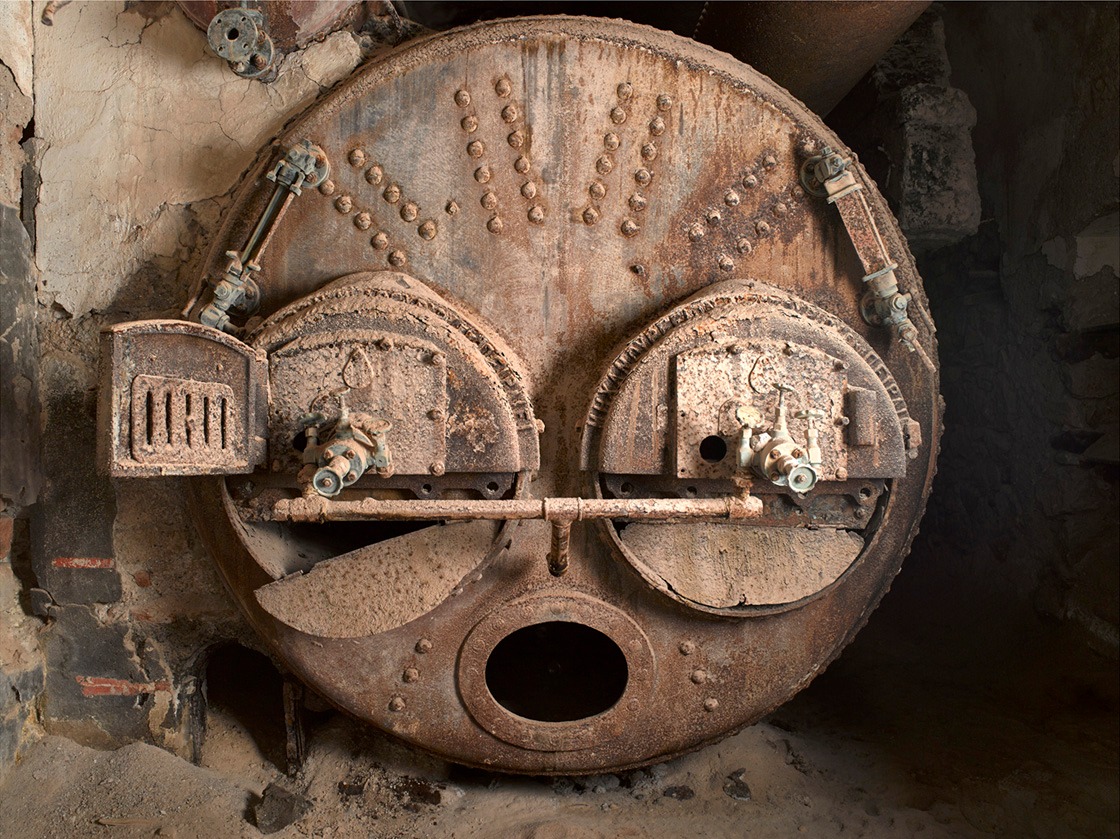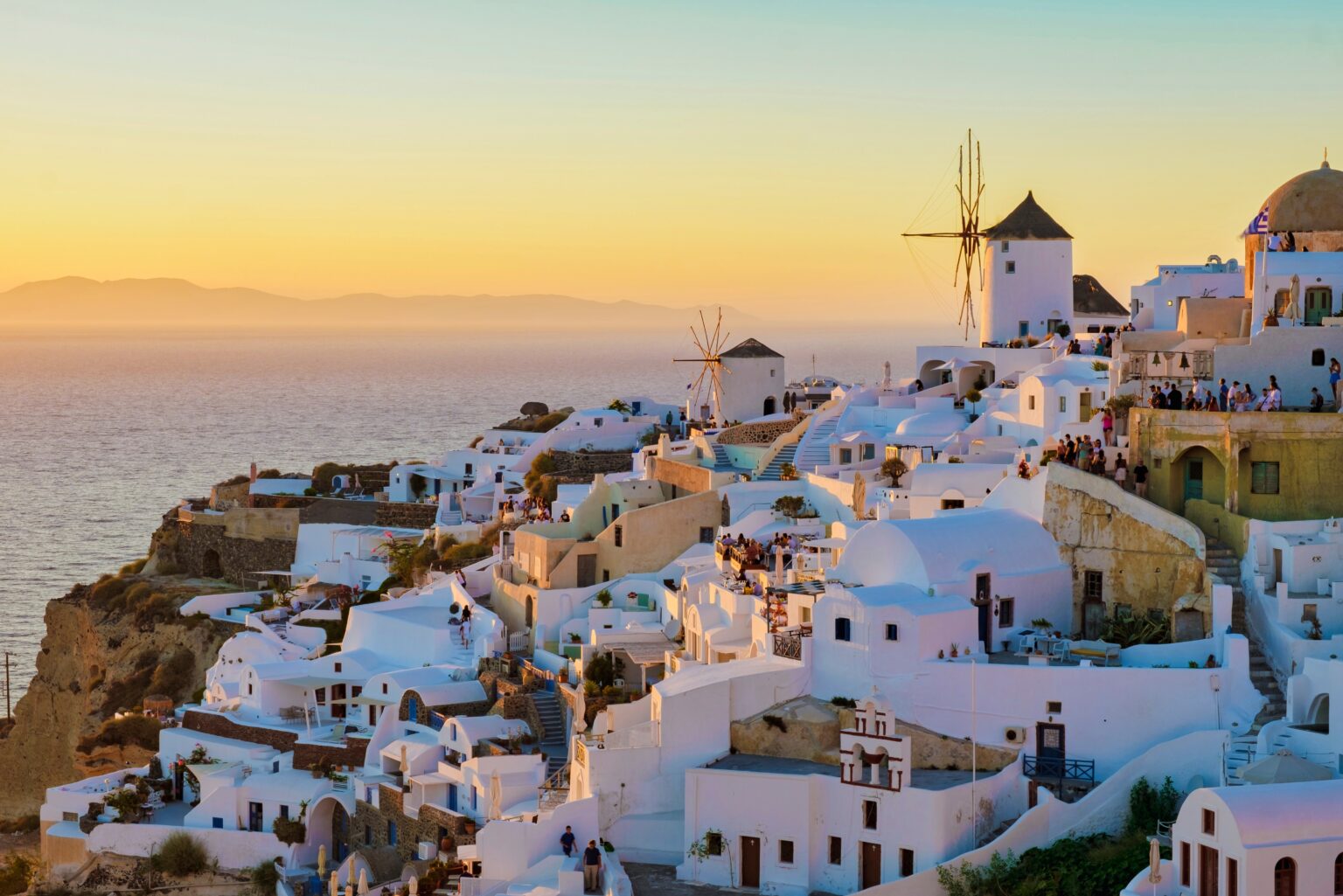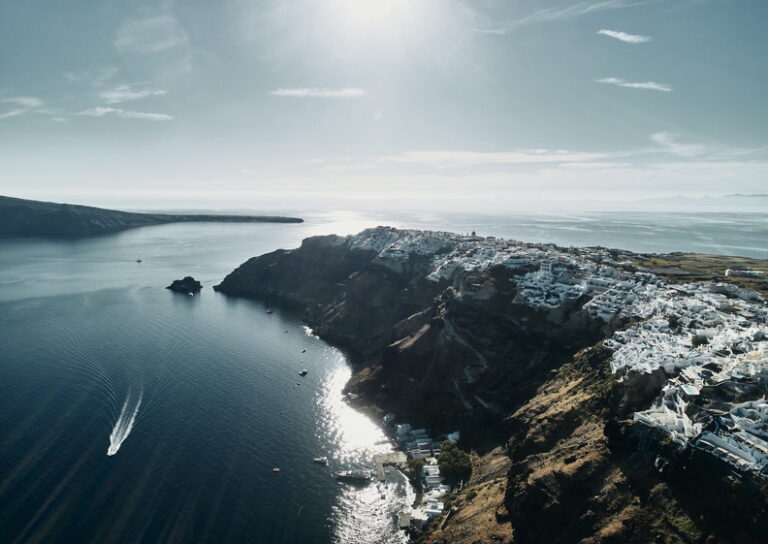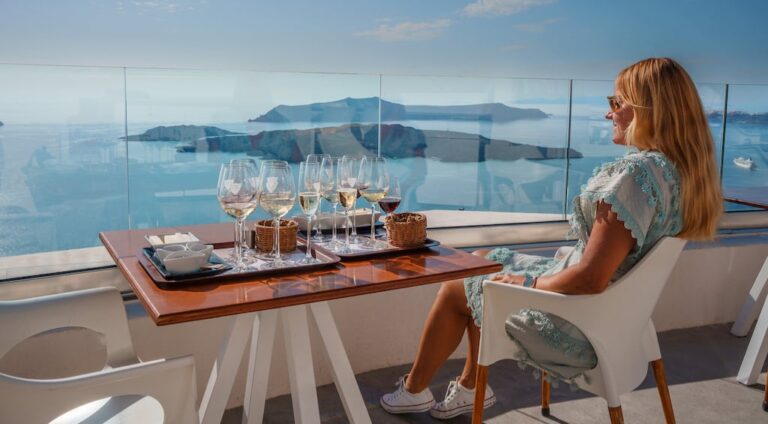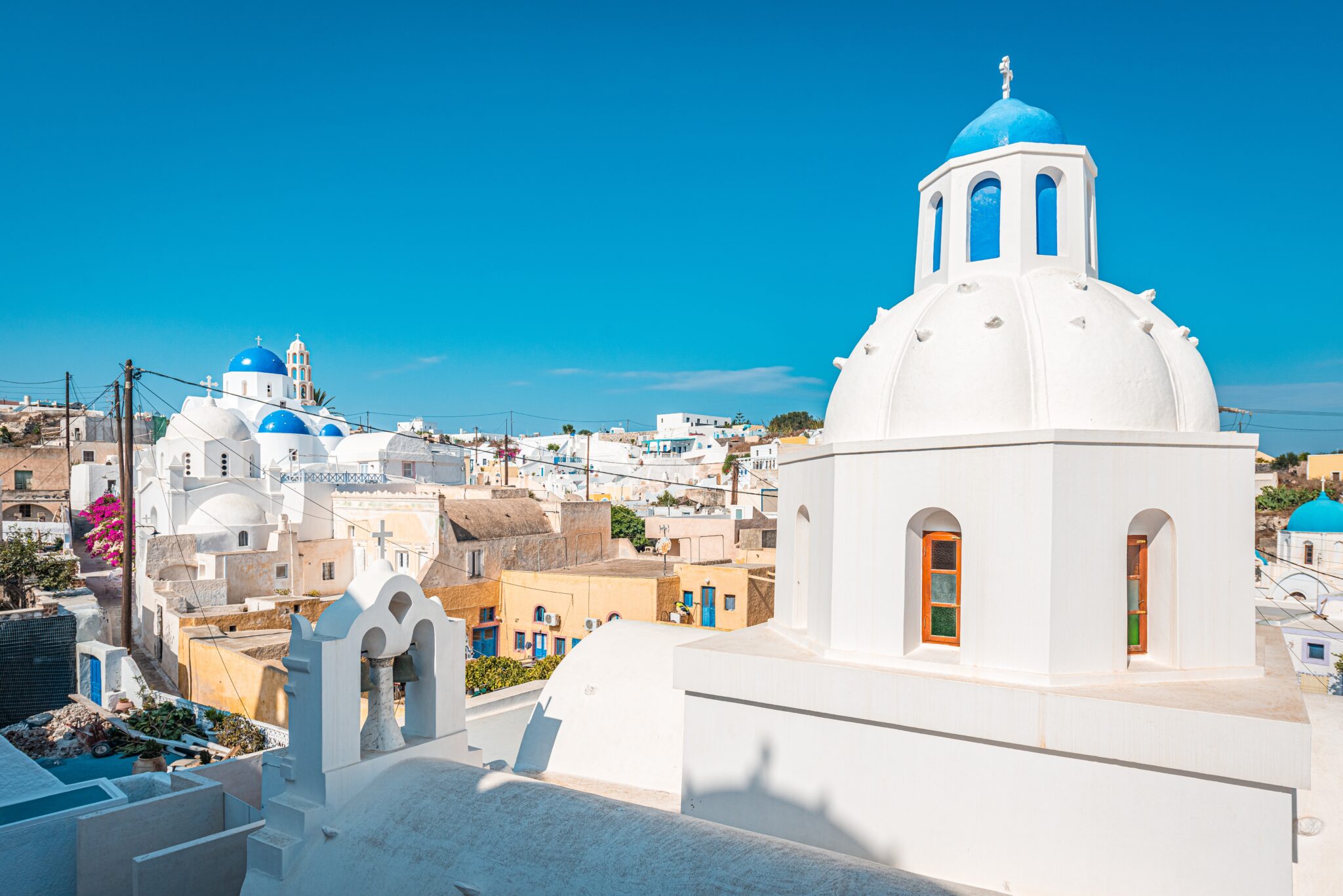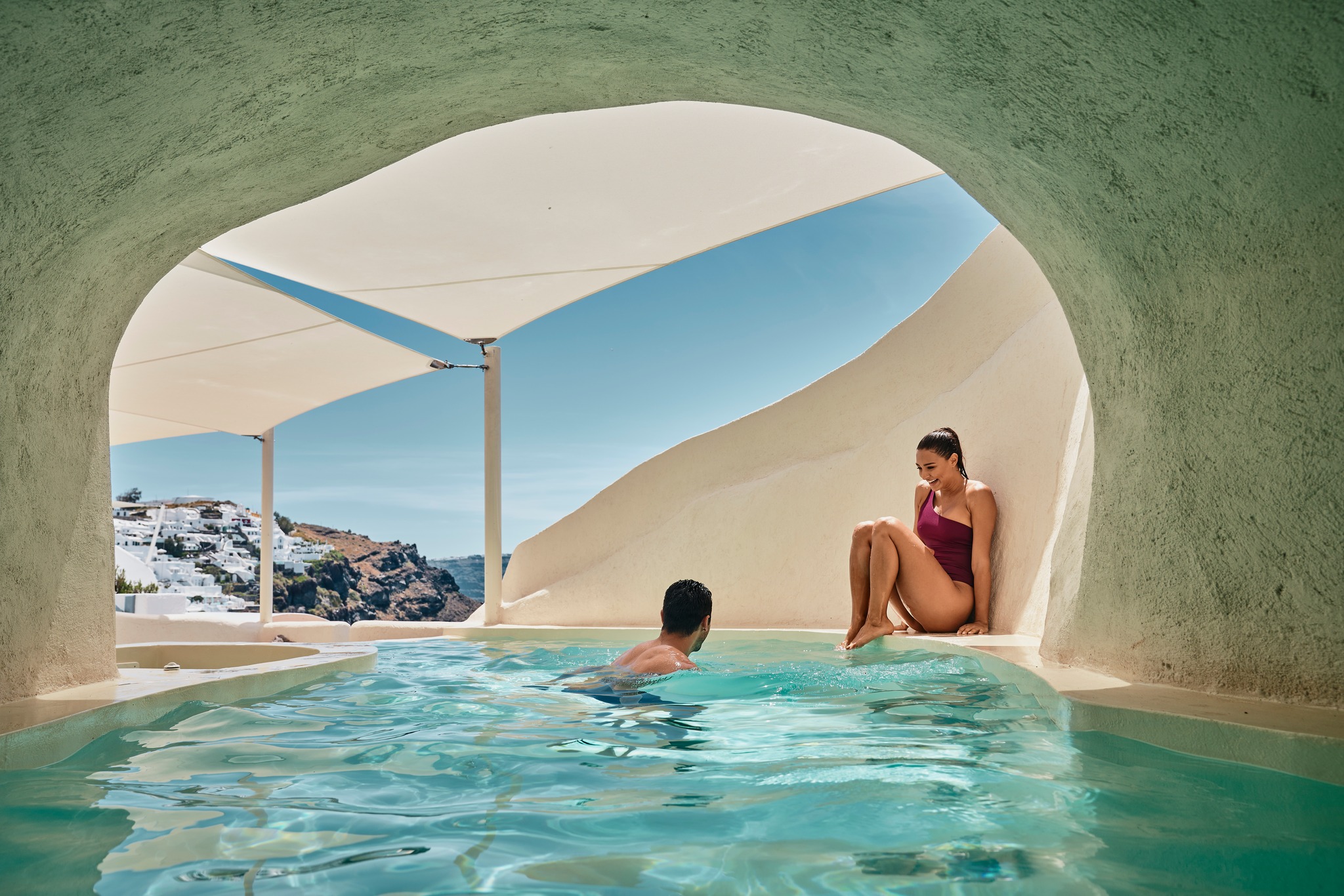The island greets you before the plane’s wheels even kiss the tarmac. From the picture-window approach to the sleek, sunlight-washed airport halls, every arrival feels cinematic, as if you have stepped onto the set of your own summer epic. Here, postcard clichés – whitewashed terraces, cobalt domes, sunsets that seem to pause time – are only the opening act.
Look closer and a richer narrative unfolds. Beneath the cliff-top infinity pools lies a Bronze Age metropolis, Akrotiri, where streets, frescoes, and wine jars have waited 3,500 years for your curiosity. Vineyards quilt the volcanic soil, producing Assyrtiko so crisp it tastes like bottled sea spray. Cherry tomatoes pack the flavor of an entire garden into a single bite, proof that drama can be delicious as well as visual.
Beyond the marquee towns of Fira and Oia, inland villages such as Megalochori and Emporio keep the rhythm slow and the coffee strong. Stone alleyways curve toward secret courtyards scented with jasmine. Locals swap harvest gossip at kafeneia that have never needed a hashtag to stay relevant.
Santorini is not just a destination; it is a layered experience that rewards unhurried exploration. Allow space in your itinerary for detours: a black-sand swim at Perissa, a hike along the caldera ridge, a midnight dance under stars bright enough to guide ancient sailors. The following ten experiences are our invitation to meet the island beyond the filter, where every moment feels both timeless and entirely your own.
01
A Recently Reopened Magnificent Museum
At the heart of Fira, where narrow lanes meet the sky and the Caldera’s vastness opens just beyond the rooftops, the Archaeological Museum of Prehistoric Thera has reopened its doors after years of silence. Light-filled, pared-back, and thoughtfully redesigned, the museum now invites visitors into a sweeping narrative that traces the earliest chapters of life in the Aegean.
Its new beginning was marked in June 2025 with the launch of Cycladic Women: Untold Stories, a powerful traveling exhibition from the Museum of Cycladic Art in Athens. Focused on the role of women in early Cycladic society, it reimagines ancient Thera through the presence, voice, and agency of its women—figures often lost to time but brought into vivid clarity here.
Beyond this exhibition, on view through October, the museum is preparing to unveil thousands of finds from across Santorini, particularly from Akrotiri. Together, they speak of volcanic origins, seaborne trade, and the slow shaping of one of the Mediterranean’s most influential island cultures.
02
Exploring Megalochori Village
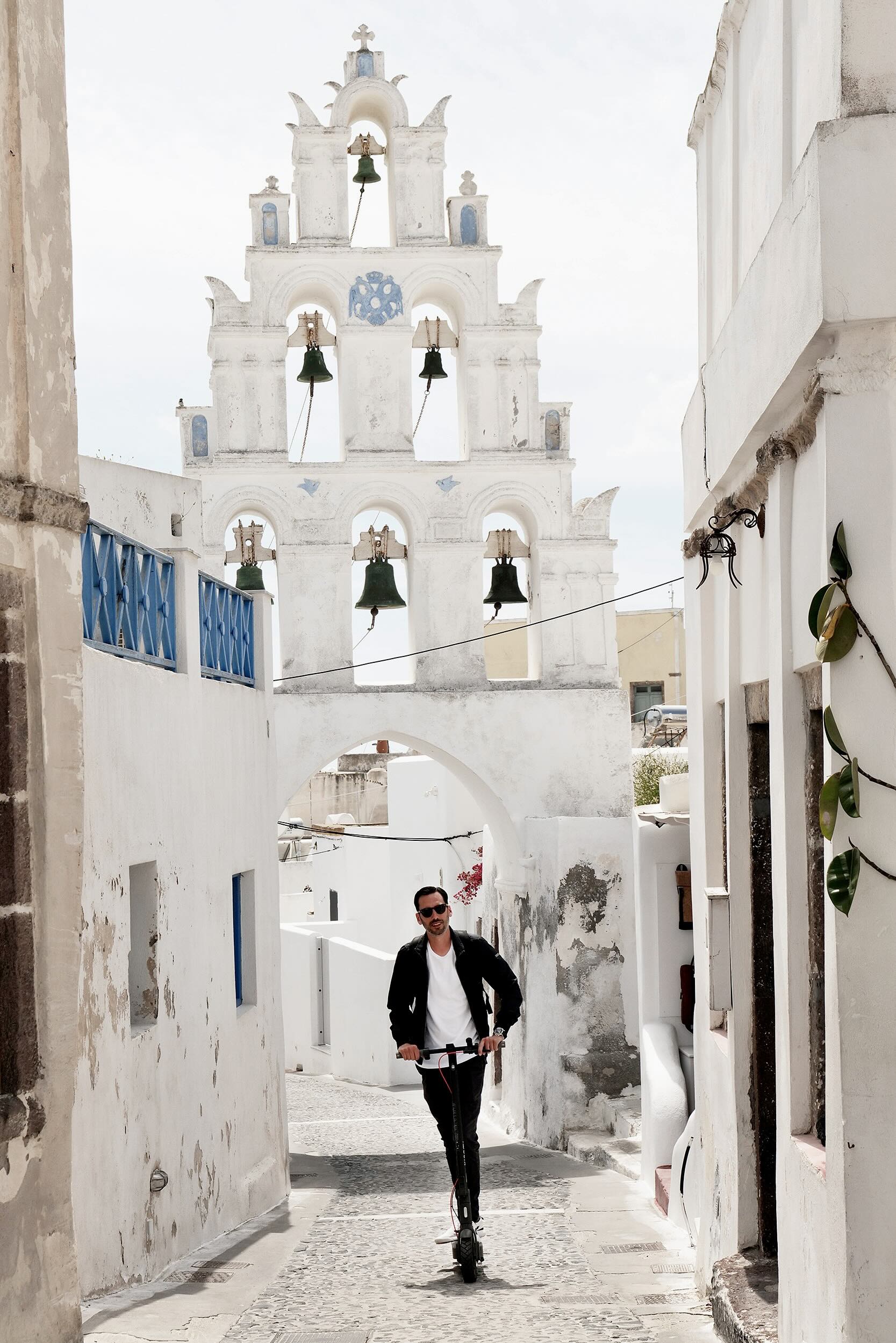

As you move south through Santorini, past the ghostlines of ancient Thera, the landscape begins to shift. Volcanic drama gives way to something softer: rows of green vineyards unfurl toward the horizon, and a quiet settlement appears among them like a memory that never aged. Megalochori feels suspended in time—earth-toned, hushed, and untouched by the island’s more showy corners.
Its cobbled alleys wind past cave houses, neoclassical facades, and sun-worn courtyards draped in vines. There’s a gentler rhythm here, held together by the scent of soil and grape skins, and the deep, familiar silence of a village that works with the land.
The bell towers stand like watchmen—especially the iconic arched belfry of the Church of Zoodochos Pigi, rising in three tiers with six bells. You’ll stop, inevitably, at the village’s old kafeneio for a spoon sweet and a glass of something cold—one last, simple ritual in a place that makes stillness feel essential.
03
Akrotiri: Cradle of Cycladic Civilisation
On the southwestern edge of Santorini, Akrotiri offers more than the ruins of an ancient settlement—it reveals an entire city, emerging slowly from volcanic ash to reclaim its place in history. Once buried for centuries beneath the fallout of a Minoan-era eruption, the site still pulses with the life of a civilization that thrived over 3,500 years ago.
Multi-story homes, paved streets, pottery jars, and vibrant wall paintings have survived almost untouched, preserved in eerie stillness beneath layers of ash. Even the town’s drainage system remains intact, bearing witness to a level of sophistication rare for its time. Every detail speaks of a Cycladic culture that was advanced, expressive, and deeply connected to the sea.
Akrotiri isn’t just a site to visit—it’s a confrontation with time. Pottery workshops, maritime trade, everyday rituals—everything reappears in uncanny clarity, collapsing the centuries between ancient Thera and the modern traveler. A walk through this city is less about ruins and more about revelation.
04
Back to Black at Perivolos Beach
Perivolos isn’t like anywhere else on the island—and for more reasons than one. On one side, it pulses all day long with the endless energy of Cycladic fun; on the other, it promises the kind of enchanting tranquility found only on truly special beaches.
Its rare natural features—the deep black volcanic sand extending from the shore to the seabed, and the intense warmth you feel when stepping barefoot onto its fine, lava-formed grains—transform swimming, and even sunbathing, at Perivolos into an experience entirely of its own.
Discover more Santorini beaches
05
Cycladic Island Hopping by Sea or Air
Santorini makes an ideal launchpad for Cycladic island-hopping—whether you’re craving whitewashed villages, lunar beaches, or just the thrill of waking up somewhere new each day. For those who want to travel in style (and skip the ferry lines), Hopper, Greece’s first scheduled helicopter service, connects Santorini with Mykonos, Paros, Ios, Naxos, and Milos in minutes. Private flights can also be arranged to lesser-known islands like Folegandros or Anafi—perfect if you’re after that off-the-radar magic with a touch of cinematic flair.
But hopping across the Aegean isn’t just for high-flyers. Santorini’s main port, Athinios, is a major hub with daily ferries (both conventional and high-speed) linking the island to Ios, Naxos, Paros, Mykonos, Syros, Folegandros, Sikinos, and Anafi, among others. During summer, connections to Crete (Heraklion and Rethymno) and mainland ports like Piraeus and Rafina are frequent and reliable. You can sail at sunrise and be sipping wine on another island by lunch.
06
Intellectual Pursuits and Wild Dreams
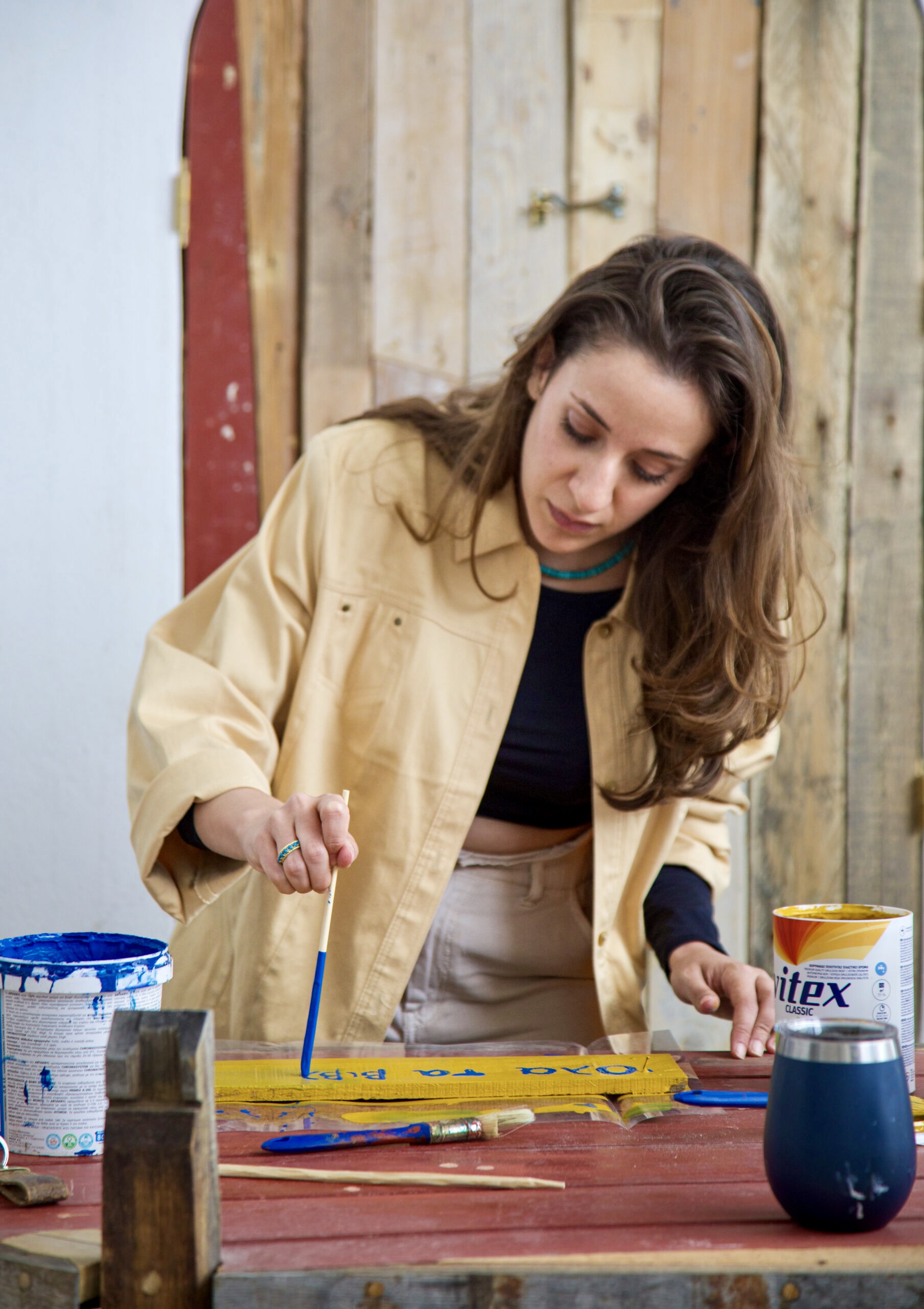

Atlantis Books began as a spontaneous idea among friends and grew into one of Greece’s most distinctive literary landmarks. For years, it was housed in a small, cave-like space in Oia—low ceilings, handwritten notes, shelves packed tight, and a caldera view just beyond the terrace. It felt handmade in every sense, from the curated titles to the painted walls and loft beds for visiting writers and staff.
In 2024, the bookstore relocated to Firostefani, finding a new home in the old Nomikos Cultural Centre. The new space carries the same spirit: thoughtfully chosen books in several languages, rare finds, local poetry, and that same quiet pull toward exploration. There’s room to pause, browse, and follow your curiosity without rush or distraction.
07
The Industrial Tomato Museum
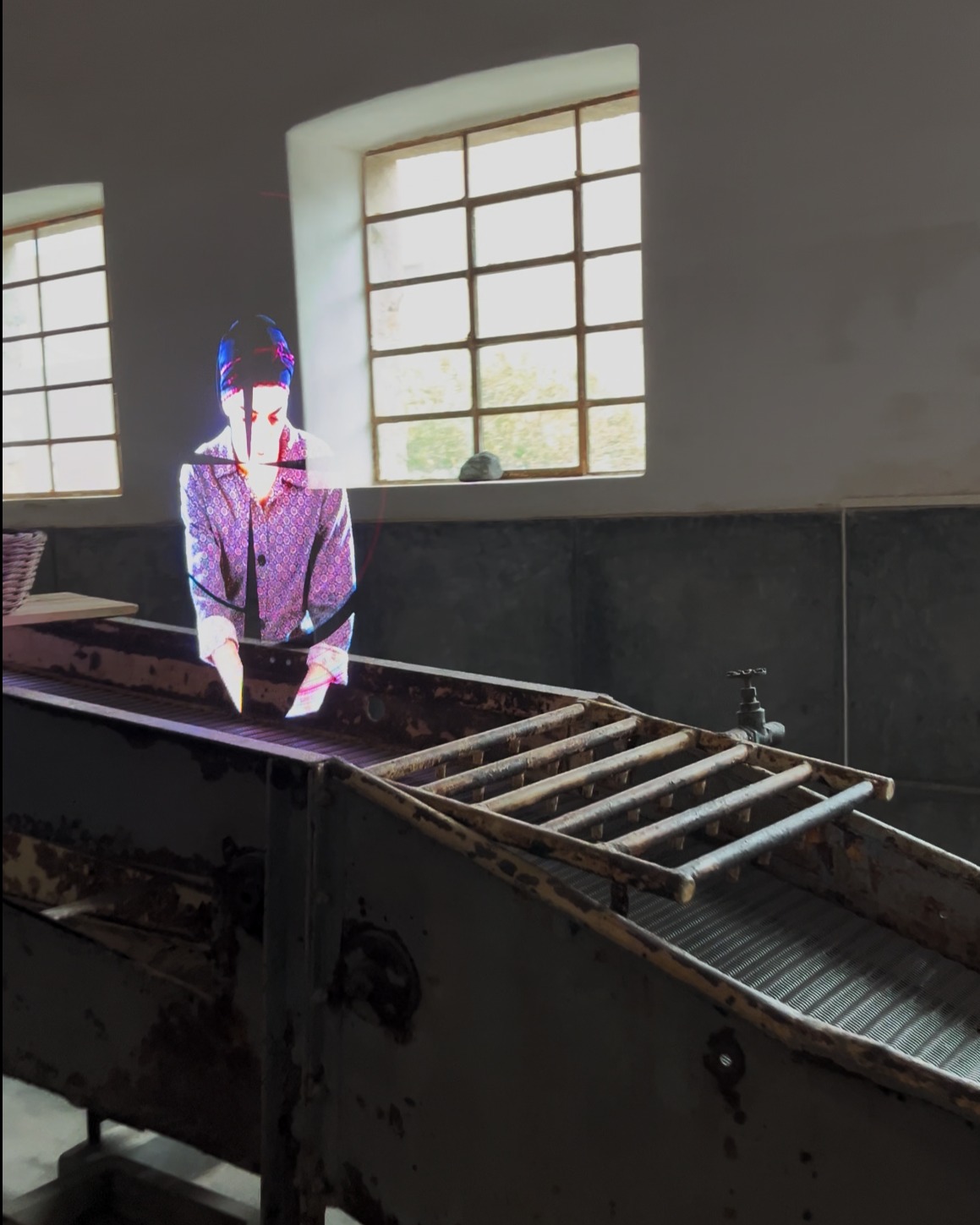
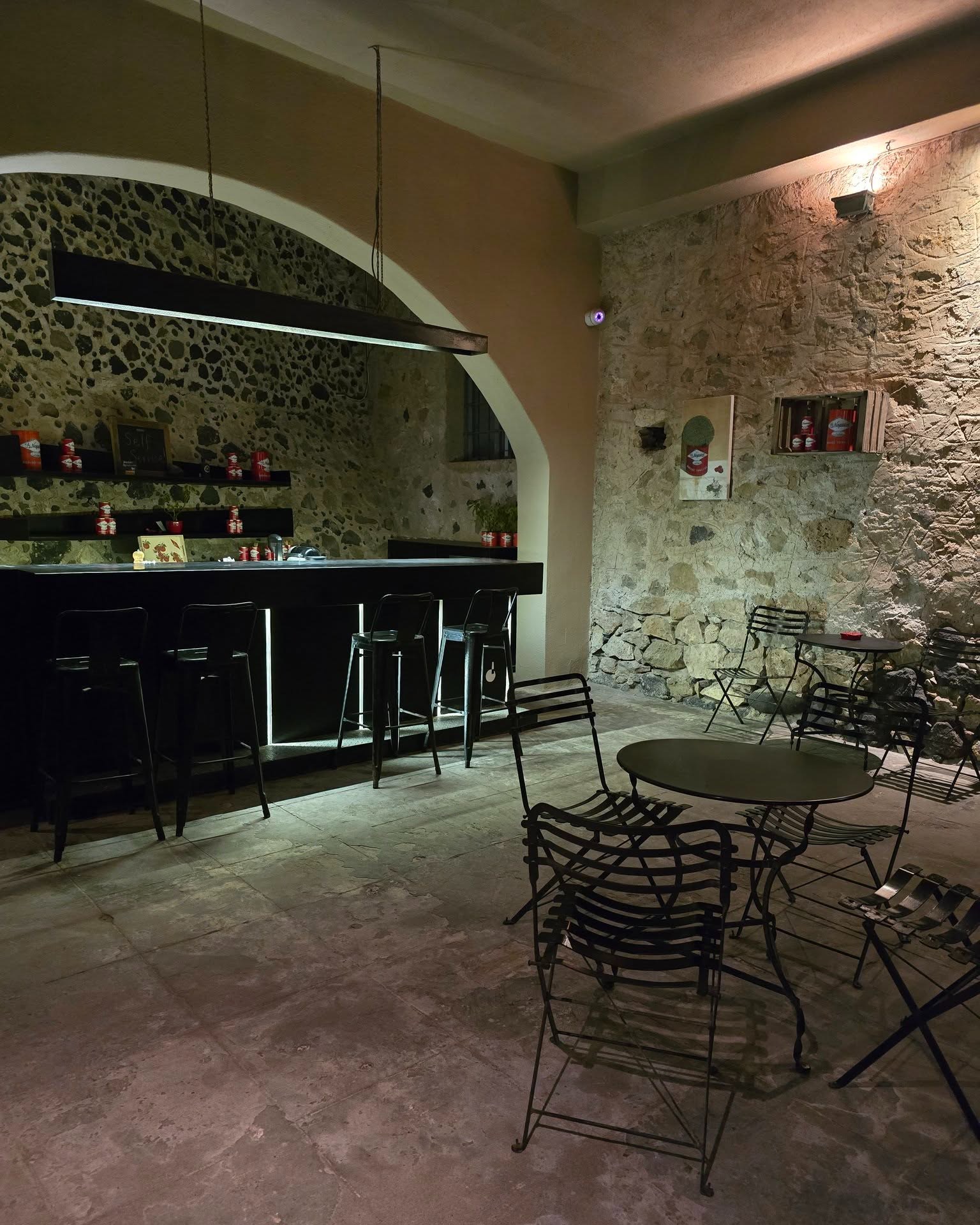
“How can such a dry, volcanic island produce the tastiest tomatoes we’ve ever had?” A fair question—one answered with charm and clarity by Iosif, our guide at the D. Nomikos Industrial Tomato Museum in Vlychada, Santorini. With a natural gift for storytelling, he walked us through a history rooted in sweat and sea air: farmers hauling 50-kilo baskets, factories a breath away from the shore, and a tomato so unique it earned global fame. The secret? Volcanic minerals and underground humidity, giving Santorini’s tiny tomatoes their intense flavor and unmistakable scent.
Inside the museum, vintage machinery and immersive projections, we learned that electricity didn’t reach Vlychada until 1995. We admired a poignant photo exhibit, eyed the shop, and lingered over tomato-infused cocktails in the café. Don’t miss the Bloody Mary—or better yet, the tomato-syrup gin served here. And if time allows, swim just behind the museum, where land, sea, and history meet.
08
Oia, Like Nowhere Else
It may be one of the most photographed places on Earth, but that’s not the half of it. Perched on the northern tip of Santorini, this cliffside village justifies every journey, every step, every mile traveled to reach it. It’s a phenomenon that continues to draw people year-round from every corner of the globe, just to see it once in their lives.
Centuries ago, this land split in two, and what remains still stuns geologists and poets alike. Oia clings to the rim of the caldera like a dream made real—whitewashed dwellings stacked in levels above the sea, blue domes rising between bougainvillea-draped terraces, light bouncing in ways you can’t explain. Morning brings a soft, milky glow. By afternoon, everything turns molten gold. And come twilight, the view flirts with the metaphysical.
Stroll its stone-paved lanes and you’ll pass restored captain’s houses, quiet art galleries, small design boutiques, and cafés with views that don’t seem quite real. The village holds tension and harmony in equal measure—Cycladic simplicity beside high-end polish, serenity alongside spectacle. And when the sun begins its famous descent, let everything else fall away.
09
Wine Tasting with a View
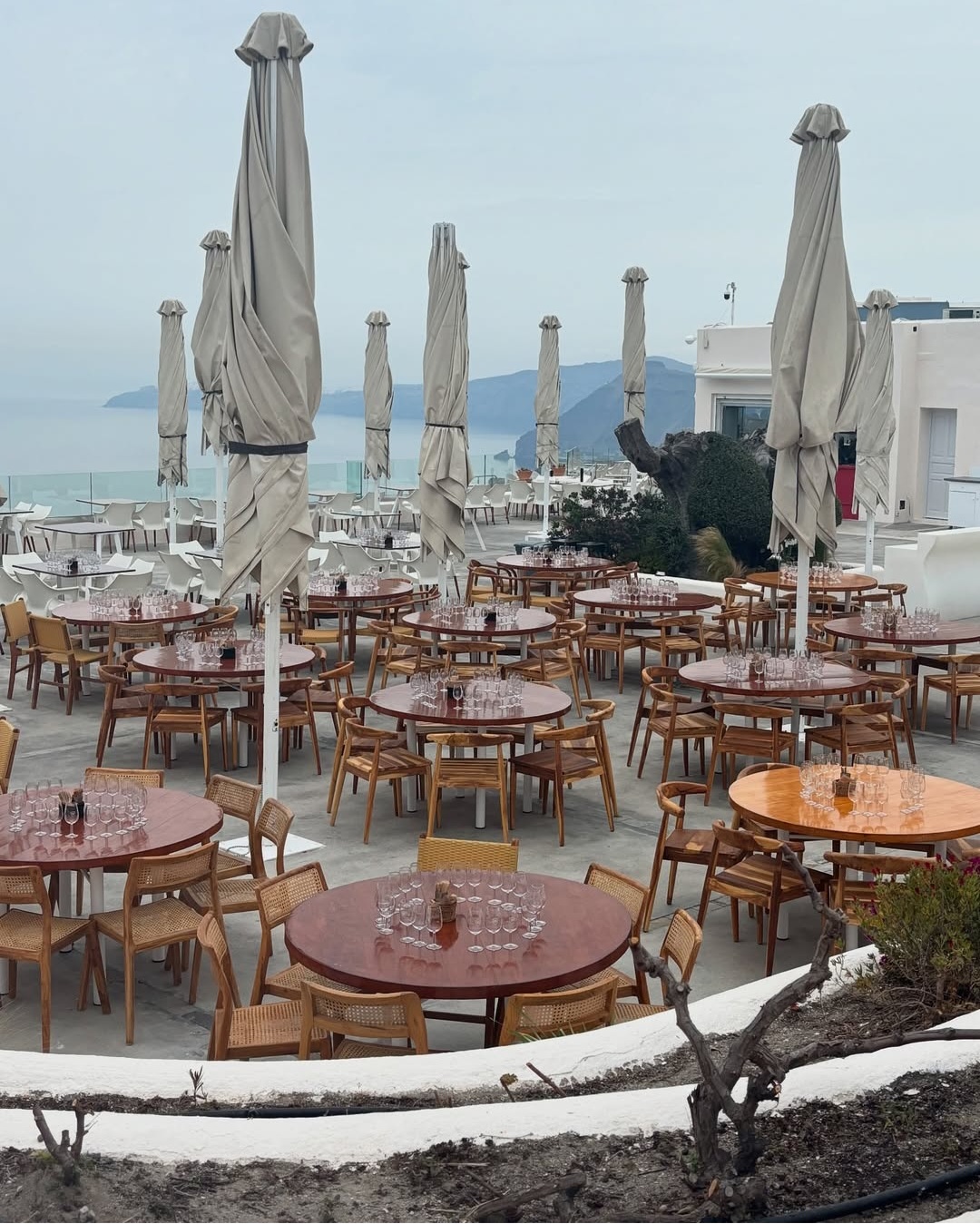
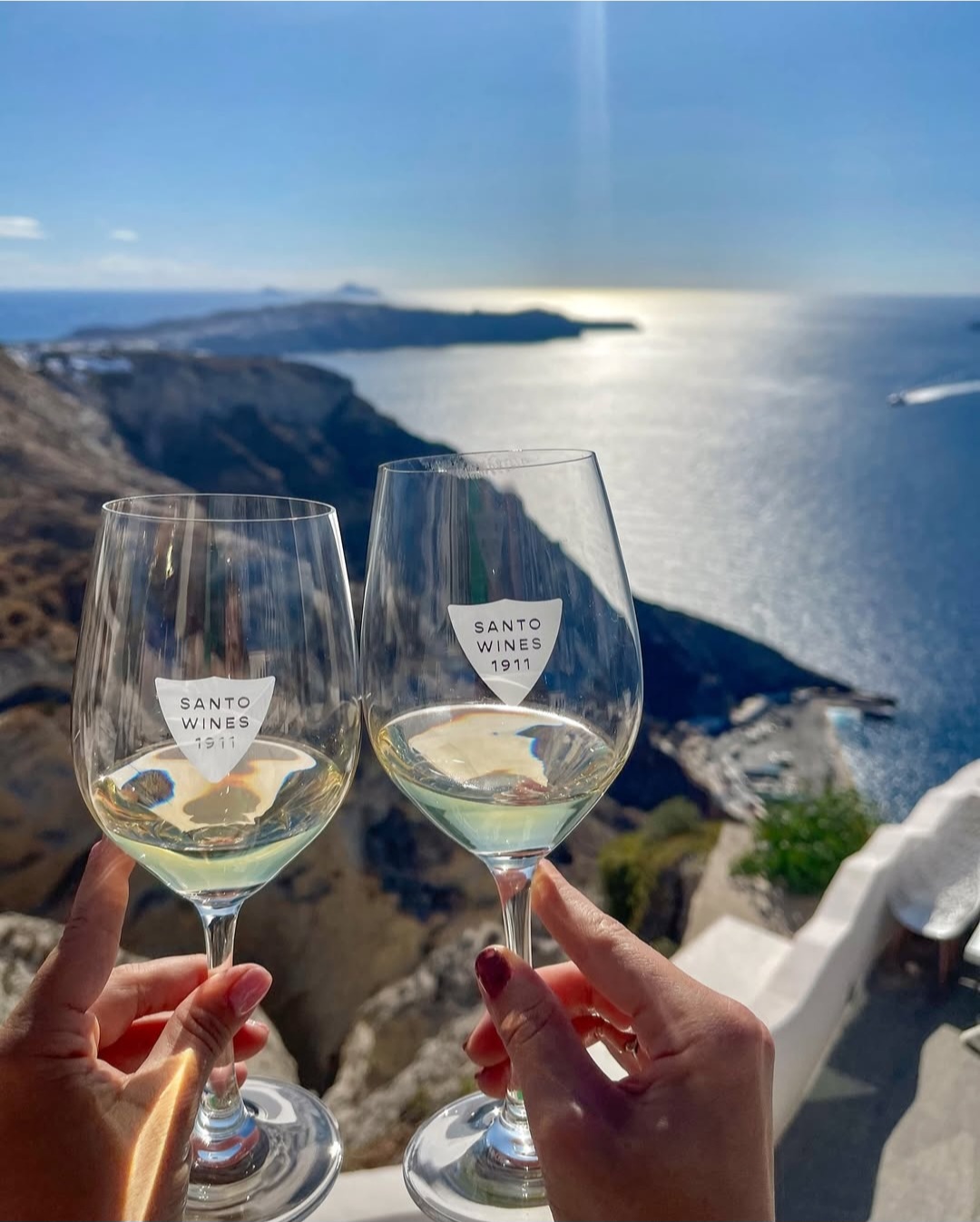
Santo Wines clings to the edge of the Caldera near Pyrgos Kallistis, where the gaze drifts out so far it feels like it might touch the sea. This is one of Santorini’s most striking spots for wine tasting—an experience shaped as much by the volcanic landscape and Aegean light as by the wines themselves.
In the terraced tasting area, guests can sample Assyrtiko with its dry, mineral bite or the honeyed depth of Vinsanto, both echoing the island’s ancient soil. Tours offer a closer look at the production and cellars, but many are content to sit with a glass and watch the sky burn into sunset.
Read more about Santorini’s wineries here
10
Sunset at Low-Key Messaria
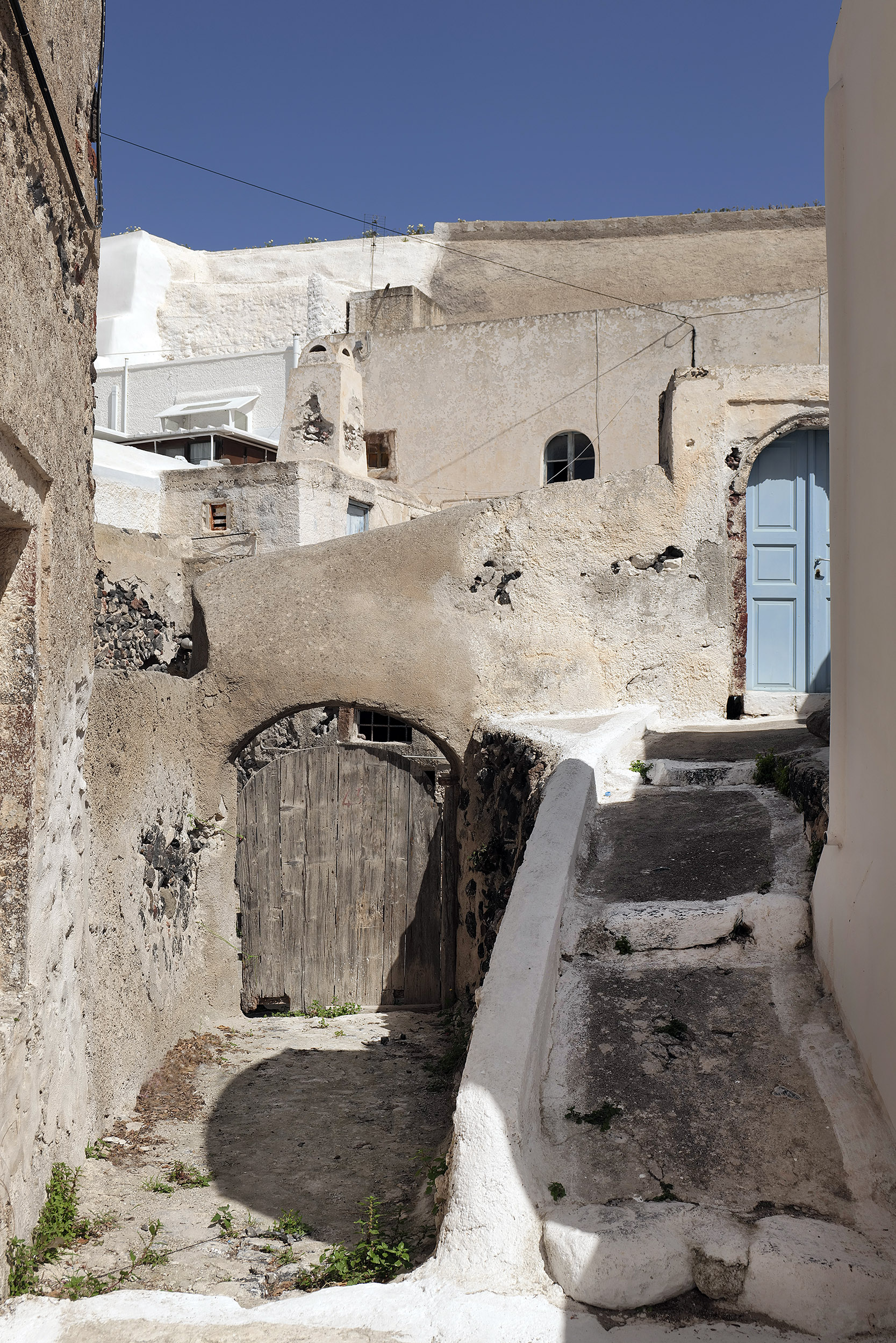
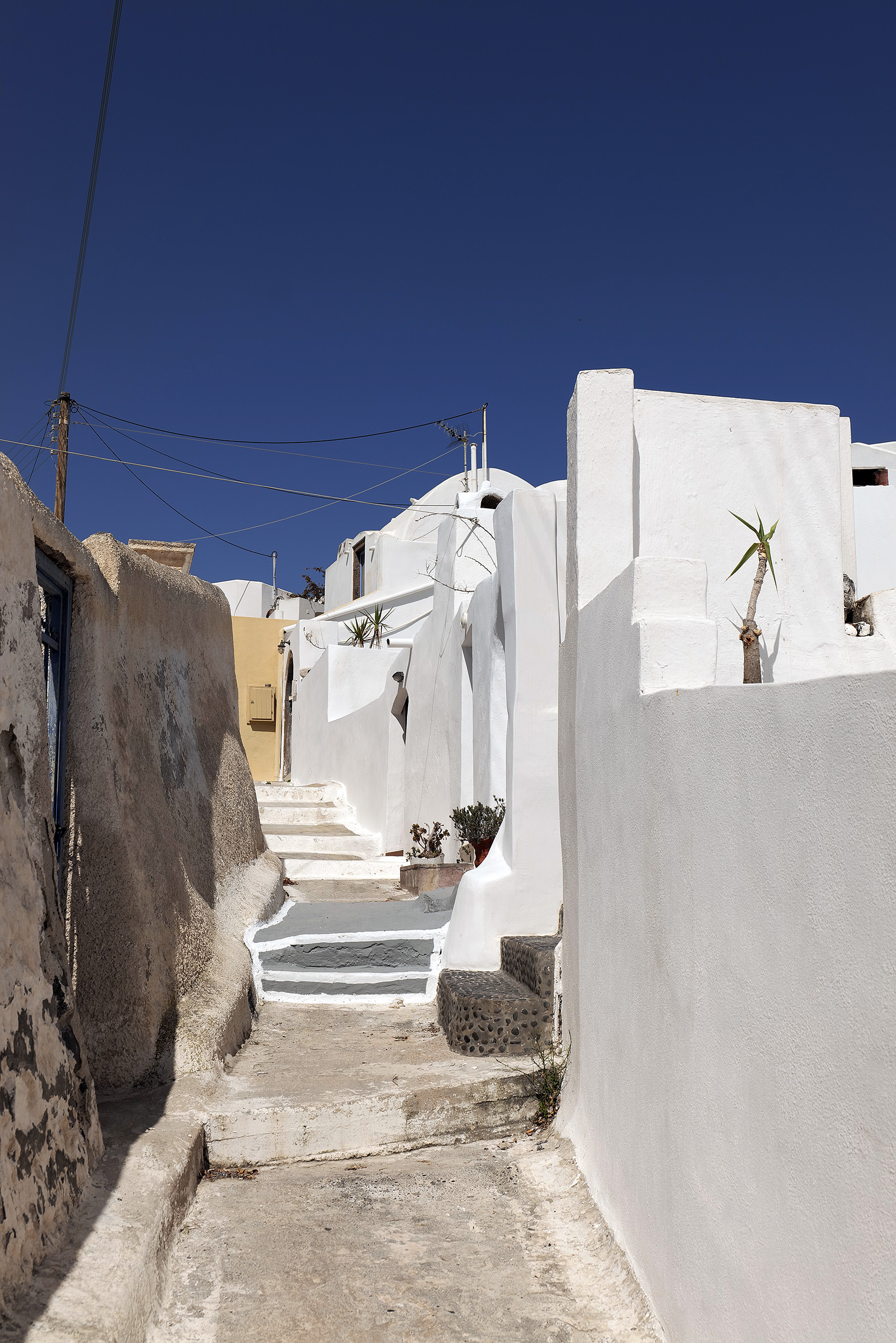
The sunset in the quiet inland village of Messaria may not have the fame of Oia or the Caldera rim, but its spell is quieter, deeper—and it stays with you. Here, the light fades differently. The sun slips behind the island in silence, steeping everything in an otherworldly calm.
Far from the crowds, the phones, the social media clamor, Messaria offers something harder to capture: stillness. The last light spills over white rooftops and blue-domed bell towers, turning the Cycladic palette into something almost sacred. In the paved alleys, time moves slowly, as if urging you to stop chasing and start feeling—just for a moment—the raw, unfiltered beauty of this place.



